Physical Address
304 North Cardinal St.
Dorchester Center, MA 02124
Radiography of the spine may be obtained to assess for vertebral alignment, fractures including compression deformities, and degenerative changes and as part of the workup for back pain. It may also be obtained to assess spinal alignment and hardware appearance after spinal fusion surgery. However, radiographs do not show details of the soft tissue structures such as the intervertebral discs, ligaments, spinal cord, and nerves.
CT of the spine is most commonly used in the setting of acute trauma to assess for fractures. However, when contraindications to MRI are present, CT may be used instead to evaluate for suspected tumor, infection, and spinal cord pathology. Intervertebral discs, spinal canal, and neural foramina are still evaluable on CT, although their visualization is inferior when compared to that on MRI. CT is more sensitive than MRI for detecting calcification, gas, and certain osseous pathologies such as spondylolysis. However, streak artifacts from metallic hardware may obscure portions of the spine in patients who have had prior surgery, leading to limited evaluation.
MRI of the spine may be obtained to assess for suspected tumor, infection, and spinal cord pathology (all beyond the scope of this chapter). MRI is the modality of choice for assessment of spinal degenerative disease and associated effects upon the spinal canal, neural foramina, ligaments, spinal cord, and nerve roots. It is also useful for evaluation of the surrounding musculature. However, susceptibility artifacts from metallic hardware may obscure portions of the spine in patients who have had prior surgery, also leading to limited evaluation.
Scoliosis refers to lateral curvature of the spine in the coronal plane, although abnormal curvature may affect spinal alignment in all dimensions. Dextroscoliosis and levoscoliosis refer to curvature of the spine with convexity toward the right and left, respectively ( Figure 47-1 ). Lordosis ( Figure 47-2 ) and kyphosis ( Figure 47-3 ) refer to convex anterior and posterior curvatures in the sagittal plane, respectively.
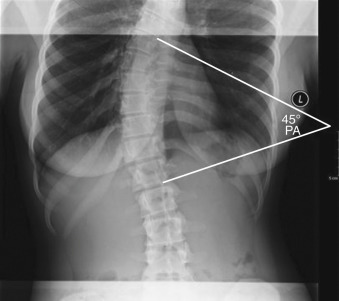
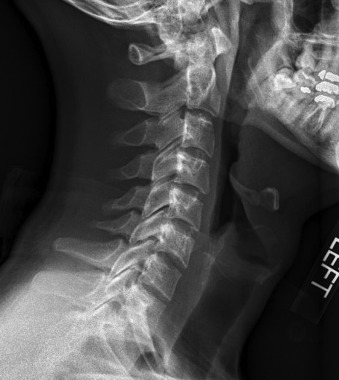
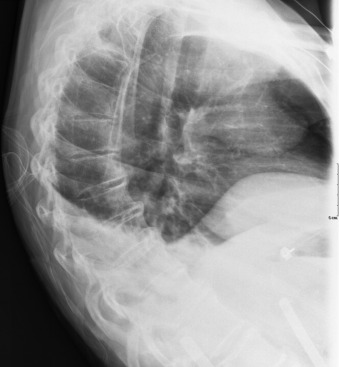
In most cases, the cause of scoliosis is idiopathic. Adolescent idiopathic scoliosis is diagnosed between age 10 and skeletal maturity and is the most common type of idiopathic scoliosis. There is a heavy predominance in girls. Although idiopathic scoliosis is the most common type of scoliosis, other etiologic factors should be considered before making this diagnosis ( Table 47-1 ).
| CATEGORY | EXAMPLES |
|---|---|
| Congenital * | Block vertebra, hemivertebra, vertebral bar |
| Neuromuscular | Cerebral palsy, muscular dystrophy, spinal cord injury |
| Developmental | Skeletal dysplasia, neurofibromatosis |
| Neoplastic * | Osteoid osteoma, osteoblastoma |
| Traumatic and other | Trauma, postradiation |
* Particularly in otherwise healthy patients, effort should be focused on excluding congenital vertebral segmentation, fusion anomalies, and neoplasms.
The Cobb angle is used to quantify scoliosis. Visually identify the vertebrae at the top and bottom of the curvature on a frontal radiograph of the spine. Draw a line parallel to the superior endplate of the top vertebral body and a line parallel to the inferior endplate of the lower vertebral body. The angle at the intersection of these two lines is the Cobb angle (see Figure 47-1 ). Scoliosis is generally considered to be present when the Cobb angle is ≥10°.
A limbus vertebra is an abnormality of the anterior-inferior corner or anterior-superior corner of a vertebral body secondary to an unfused ring apophysis of the endplate. It appears as a well-corticated ossicle, usually triangular in shape and separated from the rest of the vertebral body by lucent herniated disc material ( Figure 47-4 ).
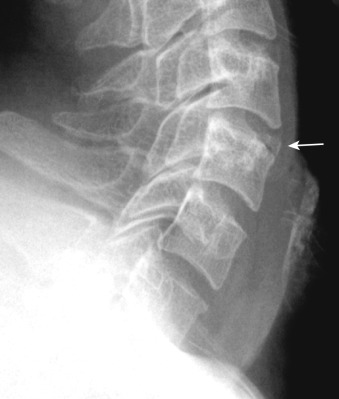
These are congenital vertebral anomalies. During development, the vertebral bodies initially form from two chondral centers, side by side, which eventually fuse to form a single vertebral body. If one chondral center fails to form, a hemivertebra results. If the chondral centers fail to fuse in the midline with residual hypoplasia remaining centrally, a butterfly vertebra results ( Figure 47-5, A ). If there is nonsegmentation of these centers from the subjacent chondral centers above or below, a block vertebra may result ( Figure 47-5, B ). These congenital anomalies can result in premature degenerative spinal disease or structural abnormalities such as congenital scoliosis and kyphosis. These anomalies should also raise the possibility of presence of other anomalies in the VACTERL complex (vertebral, anorectal, cardiac, tracheal, esophageal, rectal, and limb anomalies).
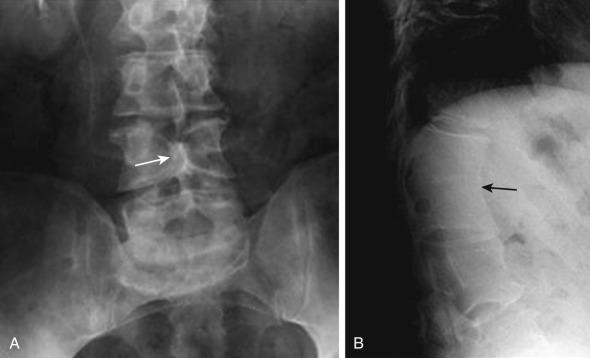
A transitional vertebra occurs when a vertebra at the junction between spinal morphological segments has features of both segments. A C7 vertebral body with cervical ribs ( Figure 47-6, A ), an L1 vertebral body with ribs ( Figure 47-6, B ), and an L5 vertebra with transverse processes that partially or completely fuse to the sacrum ( Figure 47-6, C ) represent cervicothoracic, thoracolumbar, and lumbosacral transitional vertebrae, respectively. Of these, lumbosacral transitional vertebrae are most common.
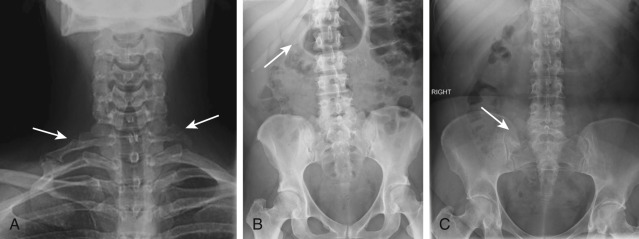
Intervertebral disc space narrowing
Intervertebral disc extension
Vacuum disc phenomenon
Osteophyte formation
Endplate changes
Schmorl's nodes
Uncovertebral joint hypertrophy (in the cervical spine)
Facet joint hypertrophy
Ligamentum flavum hypertrophy
Central canal stenosis
Neural foraminal stenosis
A Schmorl's node is a herniation of intervertebral disc material through the vertebral endplate, resulting in a lucent area at the endplate with surrounding sclerosis on radiographs and CT, and possibly with surrounding edema on MRI ( Figure 47-7 ).
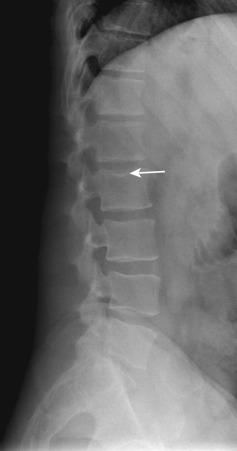
Become a Clinical Tree membership for Full access and enjoy Unlimited articles
If you are a member. Log in here